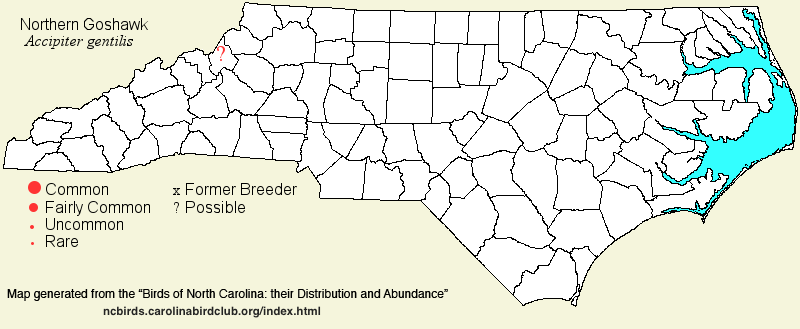 |  |
|
American Goshawk - Astur atricapillus ACCIPITRIDAE Members: | Search Common: Search Scientific: |
|
|
||||||
| General Comments |
For such a large hawk (being the state's largest Accipiter), the Northern Goshawk is remarkably secretive, and it seldom perches in the open. It is also a very rare bird at the southern edge of its range, though one or two are reported -- correctly or not -- in the state each year. However, because of the difficulty of separating immature Goshawks from immatures of Cooper's Hawk and Red-shouldered Hawk, it is likely that perhaps 25-50% of the reported Goshawks represent mis-identifications. And, because the birds are shy and always on the move -- hardly ever seen in the same area on the following days -- it is difficult to photograph or otherwise truly confirm sightings. Goshawks feed deep in coniferous or mixed forests, seldom being found around fields or other openings, nor rarely flying over open country. A few summertime sightings from higher elevations of the mountains suggest possible breeding, though no nesting has been confirmed in the state or in Virginia, though that state also has a few summer records.
In 2023, the American Ornithological Society split the former Northern Goshawk (Accipiter gentilis) into two species, one in North America and one in Eurasia. The North American one now has the names of American Goshawk and Accipiter atricapillus. In 2025, the AOS moved this species and the Cooper's Hawk out of the genus Accipiter to now Astur; so this species is currently named as Astur atricapillus. | |||||
| Breeding Status | Nonbreeder (but Possible Breeder) | |||||
| NC BRC List | Definitive | |||||
| State Status | ||||||
| U.S. Status | ||||||
| State Rank | SUB | |||||
| Global Rank | G5 | |||||
| Coastal Plain | Visitor in migration and winter; about 33 reports. Rare, mainly in winter, to the northern coast (including the Outer Banks) and Tidewater (a good handful of reports from the Lake Phelps and Alligator River NWR areas); casual along the southern coast and the northern portion of the inland part of the province. An adult was photographed on the Alligator River NWR CBC, 30 Dec 2011 [Chat 76:55 link]; and an immature was photographed at Bodie Island lighthouse pond, 3 Feb 2015 (eBird report). Apparently one far inland record south of Halifax: 1 adult, Southern Pines, 23 Oct 2002. Mostly between mid-Oct and mid-Feb, with a "peak" from late Dec to early Feb. Peak count: seemingly highly unlikely locale and date -- 2 adults, Long Beach, 19 Oct 1977. | |||||
| Piedmont | Visitor in migration and winter; only about 15 reports. Very rare to the northern half of the province, and accidental in the southern part. Dates mainly in Dec and Jan, with one in Alamance on 11 Mar 1984. All counts of one individual. | |||||
| Mountains | Visitor in migration and winter; at least 20 reports. Very rare (though more numerous here than elsewhere in the state), with the bulk of the dates from late Oct to mid-Apr, a few in Sep. Also, summer reports: 1, Grandfather Mountain, 16 Jul 1985; one or more during summer in the Cranberry (Avery) area between 1971 and 1975; and several in summer in Great Smoky Mountains NP between 1970 and 1981. Certainly, if correctly identified, the species could conceivably nest at higher elevations in North Carolina, but there is as yet no strongly suggestive evidence. Peak counts: 2-3, Cranberry area, Oct 1975. | |||||
| Finding Tips |
The species is much too rare to specifically search for, but people at hawk watches in the mountains or foothills should be on the alert for it after mid-Oct. There have been a handful of fairly recent reports from the Lake Phelps/Pungo Lake area, as well as on mainland Dare County. * | |||||
| Attribution | LeGrand[2025-09-11], LeGrand[2023-08-25], LeGrand[2023-03-20] | |||||
| NC Map Map depicts all counties with a report (transient or resident) for the species. | Click on county for list of all known species. |
| NC Breeding Season Map Map depicts assumed breeding season abundance for the species. |  |